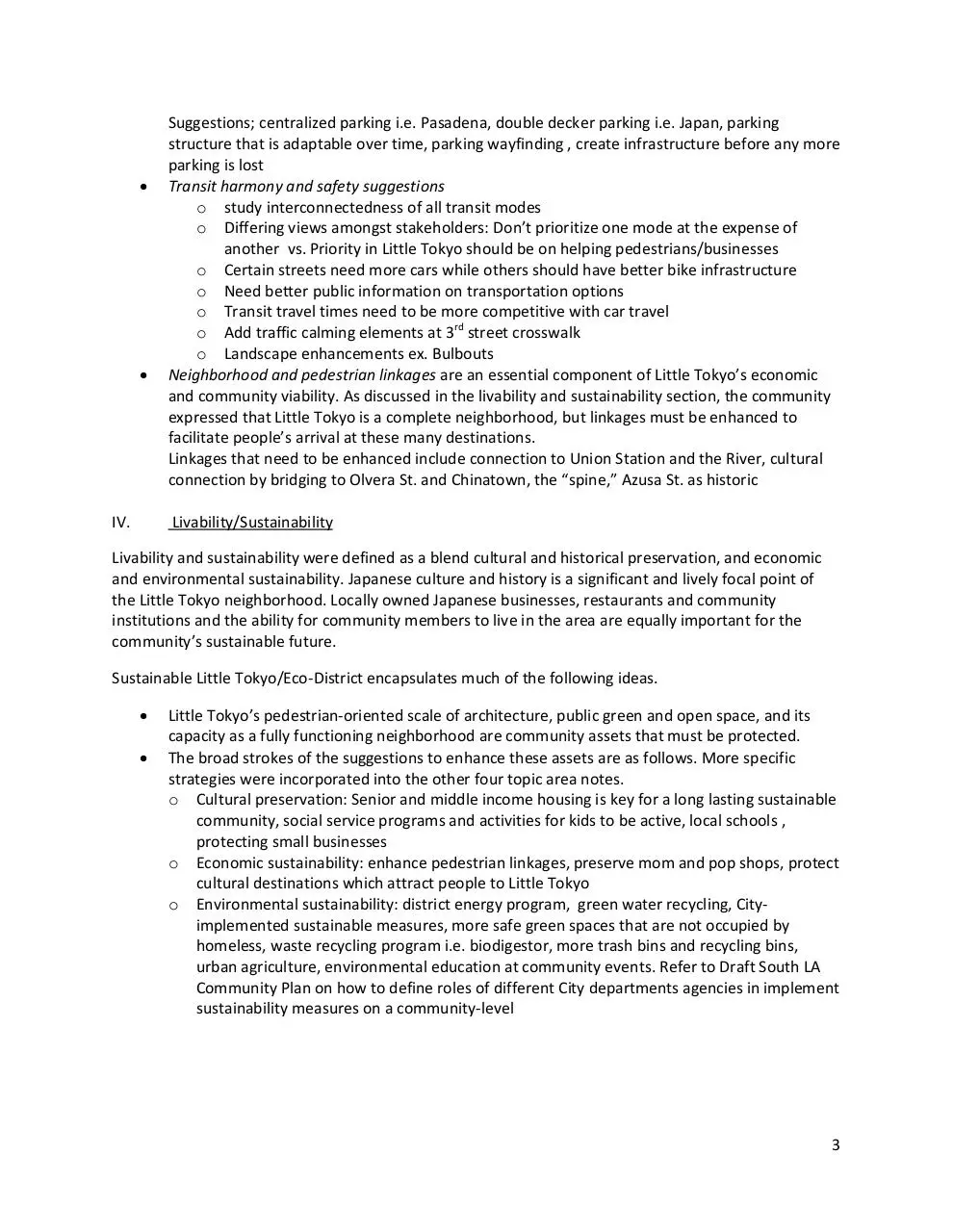Little Tokyo Workshop Synthesized Notes 1.24.15 (PDF)
File information
Author: Windows User
This PDF 1.5 document has been generated by Microsoft® Word 2010, and has been sent on pdf-archive.com on 04/02/2015 at 01:30, from IP address 161.149.x.x.
The current document download page has been viewed 458 times.
File size: 438.08 KB (4 pages).
Privacy: public file




File preview
Downtown Community Plan Update
LITTLE TOKYO NEIGHBORHOOD-FOCUSED MEETING NOTES
Saturday, January 24, 2015 │ 10:00 am – Noon │ Nishi Hongwanji Buddhist Temple
The notes below are a synthesis of the desires and concerns workshop attendants expressed during
the focus group discussions.
Discussion Topics:
I.
II.
III.
IV.
V.
I.
Land Use Development
Economic Development
Mobility
Livability and Sustainability
Urban Design
Land Use Development
Land uses should be geared toward housing. Furthermore, a diversity of unit types was
suggested to make the neighborhood affordable for a range of residents, particularly seniors
and families. Ideas for unit types include micro-units, senior housing, transitionary and SROhousing. Affordable housing needs; low- to middle- income affordable units, local housing that
is tailored to Little Tokyo’s community members and all affordability levels.
A great concern regarding commercial land uses is the preservation of local, community-owned
businesses.
Threats to the local mom and pop shops includes lack of customer parking and rising property
values in the area that drive up commercial rents. Incompatible uses on the south side of 3rd
Street were voiced as a concern, and suggestions were made to improve the transition between
these uses and the Little Tokyo businesses and homes.
There should be an enhanced awareness of cultural and historic uses, with a significant effort to
preserve and promote local cultural assets.
Historic landmarks that were cited include the uses along Central Ave. and Go for Broke
monument, the pedestrian “spine,” and the 2nd Street corridor.
A range of land use and service needs were voiced; schools, adequate short-term parking
solutions, recreation centers and parks, a residential hotel ordinance, and more nonprofits, cited
as the #1 employer in Little Tokyo.
Integrate the community needs into development standards, instead of incentives which tack on
additional entitlements and costs for developers.
Suggestions: funds for workforce housing, mixed-use housing, onsite public green space,
sustainable infrastructure, solar grid in parking lots, family and mixed generation amenities
Opportunity sites are City-owned parcels that must be accessed; The Spur, track behind Union
Station, Parker Center, Mangrove site, Office Depot, south side of 3rd, Lot 7
No pedestrian bridges or high-rises
1
II.
Economic Development
A sustainable economy within Little Tokyo is very closely linked to a vibrant cultural and historic
presence.
III.
Economic drivers; culture and history, tourism, restaurants, smaller sites for mom & pop shops,
civic uses, Temples & Churches, multi-cultural, local non-profit organizations, banking, transit
access.
Threats to local economy; displacement of local businesses, residential “gentrification corner,”
safety issues
Proposed strategies for a sustainable local economy;
o Economic incentives for small businesses – they are a vehicle for cultural sustainability
o District Wi-Fi
o Proposer marketing - “Authenticity” was suggested
o Control amount of formula retail (chain stores)
o Large employers, in hospitality or green business
o Local reinvestment of revenue collected from customer hotel fees, parking meters,
transit shelter advertising funds
o Community liaison that provides information on economic incentives and programs
Enforcement issues; HUD, loopholes on 1st Street corridor, housekeeping exemption
Mobility
The overarching theme related to mobility is to approach Little Tokyo as a system of cohesive and
interlinked transit modes. Pedestrians should be able to arrive from the future Regional Connector, or
any entry point, with a legible understanding of how to get to another destination within the
community.
Pedestrian safety was a significant concern, particularly for seniors at the 3rd St./Omar
intersection and at the 1st/San Pedro intersection and where cyclists ride on the sidewalks which
intimidates the pedestrians and seniors.
Suggested safety measures; signalized crosswalks, street lighting, bus shelters, more space for
pedestrians and people with disabilities, enhanced wayfinding, street furniture
Bike safety must be improved through new bike lanes; however effort should be made not to
displace parking. Suggestions; bike storage options in the Village Plaza, bike share program.
Pedestrians need midblock traffic signals
Increase bus routes and service hours. Suggestions; DASH should run on the weekend and at
night, cut DASH A on the weekend, more bus lines going West to Boyle Heights, more bus
arrival info, enhance bus turns around Little Tokyo
Metro/Regional Connector; there must be a transitional approach to getting people to come to
Little Tokyo by transit and the new station must be well integrated into the existing fabric.
Suggestions; Little Tokyo “Welcome” sign at Regional Connector, explore creative solutions to
conserve space and provide parking , on-call valet system in DT, free Metro pass for Nisei week
Parking is valuable to the Little Tokyo businesses and residents, and there is a delicate balance
between sufficient parking and over-parking which induces traffic. Offsetting the loss of spaces
due to the Regional Connector was often mentioned as a concern.
2
IV.
Suggestions; centralized parking i.e. Pasadena, double decker parking i.e. Japan, parking
structure that is adaptable over time, parking wayfinding , create infrastructure before any more
parking is lost
Transit harmony and safety suggestions
o study interconnectedness of all transit modes
o Differing views amongst stakeholders: Don’t prioritize one mode at the expense of
another vs. Priority in Little Tokyo should be on helping pedestrians/businesses
o Certain streets need more cars while others should have better bike infrastructure
o Need better public information on transportation options
o Transit travel times need to be more competitive with car travel
o Add traffic calming elements at 3rd street crosswalk
o Landscape enhancements ex. Bulbouts
Neighborhood and pedestrian linkages are an essential component of Little Tokyo’s economic
and community viability. As discussed in the livability and sustainability section, the community
expressed that Little Tokyo is a complete neighborhood, but linkages must be enhanced to
facilitate people’s arrival at these many destinations.
Linkages that need to be enhanced include connection to Union Station and the River, cultural
connection by bridging to Olvera St. and Chinatown, the “spine,” Azusa St. as historic
Livability/Sustainability
Livability and sustainability were defined as a blend cultural and historical preservation, and economic
and environmental sustainability. Japanese culture and history is a significant and lively focal point of
the Little Tokyo neighborhood. Locally owned Japanese businesses, restaurants and community
institutions and the ability for community members to live in the area are equally important for the
community’s sustainable future.
Sustainable Little Tokyo/Eco-District encapsulates much of the following ideas.
Little Tokyo’s pedestrian-oriented scale of architecture, public green and open space, and its
capacity as a fully functioning neighborhood are community assets that must be protected.
The broad strokes of the suggestions to enhance these assets are as follows. More specific
strategies were incorporated into the other four topic area notes.
o Cultural preservation: Senior and middle income housing is key for a long lasting sustainable
community, social service programs and activities for kids to be active, local schools ,
protecting small businesses
o Economic sustainability: enhance pedestrian linkages, preserve mom and pop shops, protect
cultural destinations which attract people to Little Tokyo
o Environmental sustainability: district energy program, green water recycling, Cityimplemented sustainable measures, more safe green spaces that are not occupied by
homeless, waste recycling program i.e. biodigestor, more trash bins and recycling bins,
urban agriculture, environmental education at community events. Refer to Draft South LA
Community Plan on how to define roles of different City departments agencies in implement
sustainability measures on a community-level
3
V.
Urban Design
Urban design elements should continue to reinforce the neighborhood’s cultural and historic identity,
while supporting pedestrian linkages to local destinations. Ultimately, Little Tokyo’s legibility is another
driver in the community’s sustainable future. Urban design principles in the Downtown Community
planning effort should support and build off of the Little Tokyo Community Design Overlay, adopted
June 2014.
Signage improvements include utility box art, standardized parking signs, small signs
Wayfinding signs; bigger signs for 1-way streets, clearer signage for bus-only lanes, way finding
for parking, freeway ramps, and electric charging stations
Neighborhood Identity; review LT sustainability plan for cultural preservation, connect building
names to historical context , needs entrance/arrival sign, identify major institutions, historic
Identity should be expressed with Japanese calligraphy, consistent lighting
Pedestrian Streetscape and Landscaping; improve connection between existing assets, widen
sidewalk, outdoor dining, consistent landscaping, parkways as bioswales
Open Space; need more gathering spaces, plazas must have electricity and trashcans,
opportunity site on north 1st. Street. i.e. FIDM model –ensures security and maintenance
Street trees important to make area walkable and pedestrian friendly. Especially at the Metro
station plaza so it is inviting for pedestrians. Refer to Street Tree Master Plan for consistency
along 1st, 2nd, 3rd streets, too many trees encroaching on west side of Central Ave.
Tree species; no one likes ficus trees, Ginkgo trees are culturally and environmentally
appropriate, buildings are tall enough in LT that shade isn’t an issue, tree canopies improve
pedestrian experience, but should not conflict with business signage
Art; would like more public and community-based art similar to Friends of LT Arts (Arts and
Architecture integrated). CDO did a good job of incorporating legacy of fine arts in LT
Building Scale and Density; pros/cons discussed regarding housing density increase. Protect
low-scale, with thoughtful transition to neighboring communities
Building design; Avoid “Disney-fied,” architectural replications, new developments should
celebrate local festivals with banners
4
Download Little Tokyo Workshop Synthesized Notes 1.24.15
Little Tokyo Workshop Synthesized Notes 1.24.15.pdf (PDF, 438.08 KB)
Download PDF
Share this file on social networks
Link to this page
Permanent link
Use the permanent link to the download page to share your document on Facebook, Twitter, LinkedIn, or directly with a contact by e-Mail, Messenger, Whatsapp, Line..
Short link
Use the short link to share your document on Twitter or by text message (SMS)
HTML Code
Copy the following HTML code to share your document on a Website or Blog
QR Code to this page

This file has been shared publicly by a user of PDF Archive.
Document ID: 0000207348.